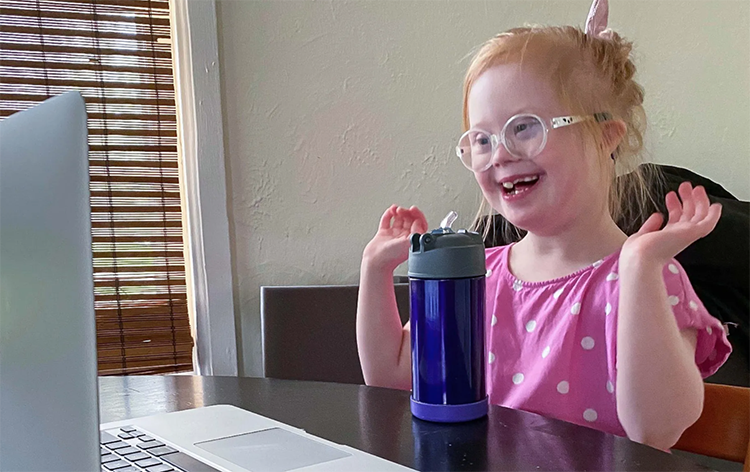
From Chalkbeat Colorado
By Melanie Asmar
Sep 3, 2021
School started in Denver two weeks ago, but 7-year-old Pearl missed the first day. And the second day. And every day since. While her peers returned to their classrooms, Pearl has been at home, waiting.
Denver Public Schools is offering both in-person and virtual school options as the COVID-19 pandemic stretches into a third school year. But Pearl’s family feels stuck between choosing the best educational setting for their daughter, who has Down syndrome, and protecting her health.
The pandemic has been difficult for all students, but students with disabilities have been especially impacted. And while most students are returning to somewhat normal routines this fall, Pearl’s situation shows not all students are able to do so.
Pearl also has asthma and other health conditions from surviving meningitis as a newborn, her mother said. A common cold has landed Pearl in the hospital, and her parents fear she’d suffer complications if she contracted COVID-19, so they want to keep her at home. But when they tried to enroll their daughter in the district’s new virtual elementary school, her application was denied.
District staff told her mother they couldn’t meet Pearl’s educational needs online. That has left the 7-year-old in limbo, and her parents frustrated and occasionally in tears.
“It is so hurtful,” said Pearl’s mother, Heidi Bricker. “Little has hurt as much as this has hurt.
“When you have a child with Down syndrome, you have one choice, and that is to advocate for them,” she said. “In this case, for the first time in her seven years, I feel like I failed.”
Miranda Kogon, associate chief of student equity and opportunity for Denver Public Schools, could not comment on Pearl’s case. But she said the district “is committed to working with each family in partnership to make sure we are meeting the unique needs of every student.”
The district’s two virtual schools — one for middle and high schoolers and a brand new one for elementary students — are accepting students with disabilities. More than 18% of students enrolled in the virtual secondary school have either an individualized education program, known as an IEP, or a 504 plan detailing the accommodations and services they’re legally entitled to receive because of their disability, Kogon said. More than 14% of students enrolled in the virtual elementary school have such plans, she said, which aligns with the district average.
There are no hard and fast rules for which students with disabilities can enroll in the virtual schools this year, Kogon said. Rather, the determination is made on a case-by-case basis by the special education team at the student’s brick-and-mortar school.
Kogon said there’s a high bar for allowing students with IEPs to be served online. School districts are required by federal law to provide students with disabilities a free appropriate public education. Though that requirement was relaxed somewhat when school buildings were closed, Kogon said that “is no longer the case because our schools are open for in-person learning and we have a strong overlay of health strategies in place for keeping kids and staff safe.”
If a special education team decides a student can’t be served virtually, and the family doesn’t want to send the child to school in person, Kogon said the family can request what’s known as homebound services, where a teacher comes to the home.
But homebound services are not a given; the district has to conduct a separate evaluation to see if a student qualifies. And while Kogon said the frequency that a homebound teacher comes to a student’s home varies, advocates say it’s rarely five days a week.
The last email Pearl’s parents got from the district a few days ago recommends Pearl be evaluated for homebound services. But Bricker doesn’t want that. Aside from her concerns about the infrequency of visits from a teacher, she said the whole idea behind keeping Pearl learning at home is to isolate her from COVID-19 exposure.
“If I was going to let someone in my home, I’d send my kid to school,” Bricker said.
Instead, she wants to continue what she and Pearl did for the past year and a half. Pearl would join her kindergarten class virtually and Bricker would sit beside her, acting as her one-on-one tutor. In real time, Bricker would modify what the teacher was saying to make it accessible for Pearl, who prefers hands-on activities to sitting at her desk.
But Bricker isn’t a teacher. She doesn’t know what to teach her now first grader. What she wants this year, she said, is access to the first grade curriculum so she can keep modifying the lessons at home for Pearl. Then, when Pearl is able to be vaccinated, she can go to school in person.
“I don’t doubt she will get COVID, but I want to prevent that from happening until she’s vaccinated,” Bricker said. “It’s within our rights as parents to do that. It doesn’t mean we should sacrifice her education to secure her safety, or be given an ultimatum.”
That’s what Bricker feels she’s been given. In meetings, she said district staff have emphasized that they can meet Pearl’s needs in person and that the schools are relatively safe. To Bricker, it feels as though her family has to choose between several bad choices — a situation they would not be facing if Pearl didn’t have a disability.
“I have a sweet red-headed 7-year-old girl here who has plenty to offer and great potential,” she said, “and she’s being declined an education.”
Photo: Pearl does a virtual session with her speech therapist this past spring. Courtesy of Heidi Bricker

